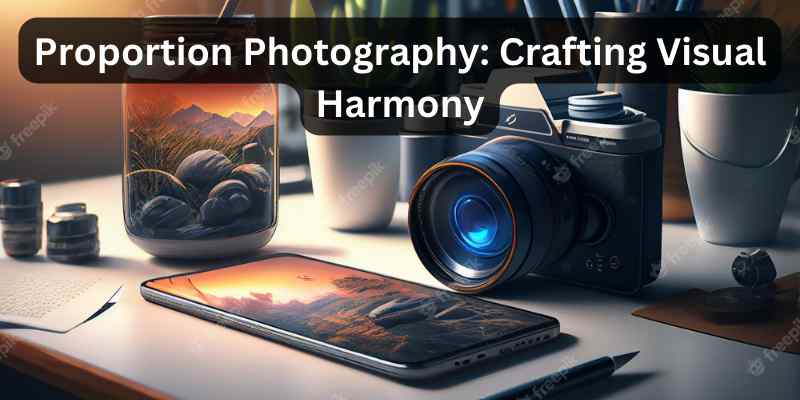Proportion Photography is a powerful form of visible storytelling, and one of the most important elements of storytelling via pics is composition. Composition includes how you set up factors in the frame, and share performs a key role in that arrangement. Proportion refers to the dimensions relationship between items in an image. It can dramatically affect the mood, focus, and balance of a photo. In this post, we’ll dive deep into percentage pictures, explaining their significance, techniques, and how you could use them to raise your picture skills.
Are You Looking for a Minot Photographer in North Dakota?

What is Proportion Photography?
Proportion images include the planned arrangement of gadgets and subjects to highlight their relative sizes and relationships in the frame. Proportion can assist convey messages, tell a tale, and evoke emotions. By manipulating the proportions of different elements for your composition, you could make a photo experience extra dynamic, balanced, or focused. Whether it’s emphasizing the enormity of a landscape or the intimacy of a close-up portrait, percentage pictures permit photographers to manual the viewer’s attention and emotions.
The Rule of Thirds
One of the maximum famous principles in proportion images is the Rule of Thirds. This method divides the frame into nine equal elements, the use of similarly spaced horizontal strains and similarly spaced vertical strains. The idea is to area key elements of the scene along these lines or, even higher, on the intersections in which they meet. This creates a more balanced and visually exciting composition.
Instead of placing the problem useless center inside the body, the Rule of Thirds allows attain a natural flow and attracts the viewer’s eye across the photo. For example, in portrait photography, positioning a subject’s eyes along one of the horizontal strains, in place of directly in the middle, can create a feel of area and make the image feel greater dynamic. The Rule of Thirds isn’t always only for snapshots; it works properly in landscapes, structure, and even product photography, where you need the viewer to be conscious of the precise elements of the scene.
Playing with Scale
Scale is one of the maximum powerful approaches to governing proportions in images. By changing the size of gadgets relative to one another, you can create dramatic consequences and emotional responses. The idea of scale can add depth, exaggerate views, or maybe create a feel of surrealism.
For instance, photographing a small concern, like someone or an item, in opposition to a huge and expansive history can emphasize its insignificance. The contrast in size can create a feeling of isolation or vulnerability. On the other hand, photographing a small challenge close-up can make it seem plenty larger and greater powerful. The scale helps the viewer interpret the connection between topics and their surroundings, and it could be a high-quality device for growing storytelling in your photographs.
Techniques for Effective Proportion Photography
Mastering percentages in pictures calls for honing sure strategies. Each one performs a role in controlling how gadgets and topics relate to every other inside the frame. Here are a few key strategies to help you use share correctly.
Framing and Cropping
Framing is the way you arrange the elements inside the shot. By listening to what’s protected and excluded, you could manipulate the proportions of your photo. Sometimes, what you leave out is just as vital as what you include. Cropping can also have a significant effect on proportions. For instance, cropping close to the concern can decorate its prominence, but at the same time leaving more space around it could diminish its importance.
Perspective
Your angle, or the angle from which you shoot, dramatically impacts the proportions of your pics. Changing your standpoint could make objects appear large or smaller, and it may modify how topics relate to one another. A low-perspective shot of construction, as an example, can make it appear grand and towering, whilst an excessive-perspective shot may additionally make it look smaller and much less enforcing. By experimenting with unique perspectives, you can manipulate how the viewer perceives the connection between objects to your image.
Lens Choice
The lens you pick out has an immediate impact on the proportions of your photographs. Wide-attitude lenses tend to exaggerate attitude, making items inside the foreground appear tons larger at the same time as pushing elements in history farther away. This can create an experience of depth and drama for your composition. Telephoto lenses, then again, compress the scene, bringing gadgets closer together and making them appear more calmly proportioned. Choosing the right lens in your concern depends on and means composition is crucial to reaching the preferred effect.
Proportion Photography in Practice
Now that you understand the idea at the back of sharing pictures, let’s explore the way to follow these standards in actual international eventualities.
Portrait Photography
In portrait pictures, the relationship between the challenge’s face and the heritage plays an important role in the basic effect of the picture. The percentage of the subject’s face to the heritage can convey feelings, add intensity, and create an experience of intimacy. For instance, in near-up pix, focusing on the situation’s face and blurring the background could make the situation seem larger than lifestyles and draw the viewer’s attention without delay. Additionally, using the Rule of Thirds in photographs, such as aligning the subject’s eyes with one of the intersections, can beautify the composition and balance the image.
Another essential aspect of sharing pictures is the size and location of the subject inside the frame. Placing the concern too small within the composition would possibly make them seem insignificant while placing them too huge would possibly make the photo feel unbalanced. Experimenting with the location of your difficulty and considering their proportions relative to the background can result in a more harmonious and engaging image.
Landscape Photography
In panorama images, proportions are important to growing a balanced and engaging composition. The proportions among the foreground, center floor, and history elements can help create intensity and manual the viewer’s eye through the scene. For example, giving equal weight to the sky and the land in a landscape shot can create an experience of symmetry, at the same time as emphasizing one detail over the opposite can create an experience of drama or attention.
The horizon line in a panorama image is a powerful tool for dealing with proportions. Placing the horizon inside the decreased 0.33 of the body, for instance, can allow the sky to absorb more area, creating an experience of openness. Alternatively, positioning the horizon better in the body can make the land or water the focus of the composition, creating a specific temper.
Architectural Photography
In architectural pictures, proportion is key to preserving accuracy and symmetry. The dating between construction and its surroundings, in addition to the traces and angles of the structure itself, could make or wreck the composition. To hold proportions accurately, it’s vital to apply instantly lines and avoid distortion caused by wide-attitude lenses.
When photographing buildings, the scale and scale of the structure in terms of the surroundings must additionally be taken into consideration. Shooting from a distance or the use of a telephoto lens can assist in compressing the space and give the construction more prominence within the body. If you’re photographing a big building up close, using an extensive-attitude lens can make it appear more dramatic and towering.
The Emotional Impact of Proportion
Proportion in photography isn’t always pretty much creating stability—it’s also about evoking feelings. The manner you manage proportions can dramatically impact how the viewer feels after they study the photograph. For instance, an image with exaggerated proportions may additionally feel surreal, at the same time as one with extra balanced proportions may additionally feel calm and harmonious.
Manipulating proportions also can adjust the manner a viewer perceives a subject. By making positive elements seem large or smaller, you can emphasize their importance or insignificance. This can create a sense of hysteria, serenity, or intimacy, depending on the proportions you choose. In essence, the emotional impact of a photo can regularly be decided through how the proportions are handled.
How to Use Proportion in Your Photos
Using share on your pics doesn’t ought to be complicated. It’s about being conscious of the connection among items for your body. Start by means of considering the dimensions of your challenge and how it interacts with the history and surrounding elements. Is it the focus of the composition, or does it play an assisting position?
Experimenting with special compositions is prime to locating the proper stability. Try the usage of the Rule of Thirds, adjusting the size of gadgets, or experimenting with unique perspectives to see what works in quality. By taking note of the proportions for your pics, you can elevate their visual enchantment and create more engaging photos.
Why Is Proportion Important in Photography?
Proportion is important in images as it enables create balance and concord inside the frame. Well-managed proportions make certain that no problem overpowers another, leading to a more aesthetically attractive picture. By expertise and applying proportion, you can manual the viewer’s eye, evoke feelings, and create a more effective composition. Whether you’re photographing people, landscapes, or gadgets, learning proportion images will make your pix stand out and speak your intended message.
Conclusion
Mastering proportion photography is an essential talent for any photographer. By manipulating proportions, scale, and angle, you can create captivating images that evoke particular feelings and bring effective messages.Mastering proportion in photography enhances composition, elevating the quality of your photos, whether capturing portraits, landscapes, or architecture. Don’t be afraid to experiment with distinct strategies and perspectives. The greater you exercise, the greater your ability to use share to craft visual concord will grow, leading to greater dynamic and impactful snapshots.
FAQs
1. What equipment is best for proportion photography?
Proportion photography doesn’t rely on specific equipment. It’s more about understanding composition and perspective. Any camera, from a smartphone to a DSLR, can be used effectively.
2. Are there any apps or tools to help with the Rule of Thirds?
Yes, many photography apps provide grid overlays that can assist you in applying the Rule of Thirds while shooting.
3. Can I use proportion photography in black and white photography?
Absolutely! Proportion photography is a technique that transcends color. It can be just as impactful in black and white as in color photography.
4. Is proportion photography suitable for beginners?
Yes, it’s a fundamental aspect of photography that anyone can learn and apply. It’s a great starting point for beginners looking to improve their composition skills.
5. How can I practice proportion photography?
The best way to practice is by taking your camera and experimenting. Try different compositions, angles, and perspectives to see how they affect the overall proportion of your images.
What is a pattern in photography?
A pattern in photography is the repeated use of shapes, colors, or textures to create visual harmony in images.








